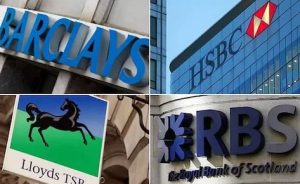This report is not a personal recommendation and does not take into account your personal circumstances or appetite for risk.
The Banking sector is an important one to have been caught up in the recent sell-off; down 15-26% year to date. That said UK banks have at least outperformed EU counterparts ( banks -20% year to date vs. STOXX Europe 600 Banks -30%). Germany’s troubled Deutsche Bank, for example, is in the red by a whopping 56%!
In London, the worst performer is Barclays; the best is HSBC. Bargain hunting traders and investors are currently circling. It is widely accepted that Banks are “risk assets”, given how interlinked they are with the wider economy, the growth of which we are so concerned about.
 Higher interest rates are good for banks, yes, but only if economic growth can cope with those higher borrowing rates. That way banks can charge more for what they lend versus what they pay money on deposit. That said, the US may be raising rates, but the ECB is only starting to reverse its QE. And closer to home, the Bank of England remains in wait and see mode ahead of the UK’s scheduled departure from the EU. Whenever than may be.
Higher interest rates are good for banks, yes, but only if economic growth can cope with those higher borrowing rates. That way banks can charge more for what they lend versus what they pay money on deposit. That said, the US may be raising rates, but the ECB is only starting to reverse its QE. And closer to home, the Bank of England remains in wait and see mode ahead of the UK’s scheduled departure from the EU. Whenever than may be.
So do the banks represent a bargain opportunity or a basket case sector? In a way, Lloyds at 51p, -25% year-to-date, to its lowest since the aftermath of the Brexit vote, looks a steal. Especially when you take into account its 7% consensus forward dividend yield. On the flip-side it is also the most exposed to the UK housing market, which is itself hostage to the UK economy, interest rates and, of course, Brexit.
So if you are confident that Brexit is nothing to worry about, then Lloyds could well be oversold at 50p. It tried a 49p handle briefly but is already back at 51p. If you think that there could be worse to come, then perhaps we need to revisit 48p: 5.5yr shallow rising support. Perhaps we need to see 43p again which coincides with rising support since the financial crisis lows of 16.5p.
This is just one example. Royal Bank of Scotland (214p, -23.2% YTD) has more business banking, Barclays (150p, -26.1%) is more international, while both HSBC (648p, -15.4%) and Standard Chartered (602p, -22.8%) are more Asia sensitive, which on the one hand insulated them from Brexit woes, but on the other hand means more exposure to China-US trade war concerns.
So none are fully insulated and performance is rather similar. So too are their dividend yields. While Standard Chartered offers just a 4% yield, the rest of the quintet offer consensus forward yields of 5-7%, all well north of what any of these banking giants will offer you for cash held on deposit.
On a more general note, some 2018 stats on the UK Index which could help both bulls and bears with convincing them that it is either bargaining hunting season or the trend is their friend. As it stands 7% of UK 100 is down more than 35% year to date; 10% are down more than 30%; 21% down more than 25%; 37% down more than 20%; 47% down more than 15%; 56% down more than 10%; 66% down more than 5%. On a brighter note 25% of the UK 100 is positive YTD; 18% is up more than 5%; 13% up more than 10% and, lastly, 5% up more than 15%. Something for everyone, Bulls or Bears.
Whether you see the index components offering bargain opportunities or baskets of trouble, and in the same vain as my colleague’s closing comments today, remember this: If you think a share price looks good value and fancy taking a position, there is no obligation to buy the whole position in one go.
Providing it is cost effective in terms of commission costs, why not split the trade? That way, if you buy now and the price falls, you can buy more at a lower price. Think of it as lowering your average entry price if the share price falls. And if the shares do rally, you can always buy more on the way up, buying into momentum. You will at least have bought one lot closer to the the bottom!
 After an exciting 2018 may I offer all readers my best wishes for the New Year. If not already, please subscribe to our Gold Pass trading opportunity package to make sure that from next week you receive two short-term trade opportunities per day from each of our Momentum, Breakouts, Support and Range categories, along with much, much more.
After an exciting 2018 may I offer all readers my best wishes for the New Year. If not already, please subscribe to our Gold Pass trading opportunity package to make sure that from next week you receive two short-term trade opportunities per day from each of our Momentum, Breakouts, Support and Range categories, along with much, much more.
As I said last week, consider it a New Year’s resolution, ensuring you are ready to make the most the multitude of trading opportunities which will materialise. Not just in January but in 2019 as a whole.
Here’s banking on a better 2019!
Mike van Dulken, Head of Research, 28 Dec 2018
This research is produced by Accendo Markets Limited. Research produced and disseminated by Accendo Markets is classified as non-independent research, and is therefore a marketing communication. This investment research has not been prepared in accordance with legal requirements designed to promote its independence and it is not subject to the prohibition on dealing ahead of the dissemination of investment research. This research does not constitute a personal recommendation or offer to enter into a transaction or an investment, and is produced and distributed for information purposes only.
Accendo Markets considers opinions and information contained within the research to be valid when published, and gives no warranty as to the investments referred to in this material. The income from the investments referred to may go down as well as up, and investors may realise losses on investments. The past performance of a particular investment is not necessarily a guide to its future performance.
Prepared by Michael van Dulken, Head of ResearchComments are closed.
Accendo Markets is an award-winning provider of CFD and spread betting trading services. We provide an execution-only service.
Telephone calls and online chat conversations may be monitored and recorded for regulatory and training purposes.
* We provide these as underlying assets to CFDs and Spreadbets.
To view our policies and terms, please click here
This website is not intended for or directed at residents of the United States or any country outside the UK. It is not intended for use by or distribution to any person in any jurisdiction or country where its use or distribution would contravene any regulation or local law.
Prices on this page are delayed.
Like many websites, we use cookies for statistical purposes and to acquire information on general internet use. This helps ensure that you get the full benefit of our services, and enhances your browsing experience . For more details on the cookies we use, view our privacy policy under the heading 'How We Use Cookies'. By using this website, we'll assume that you're happy to receive all cookies from Accendo Markets.
Removing cookies may impede the operation of some parts of this website. For general information about cookies and how to remove them, please click here
